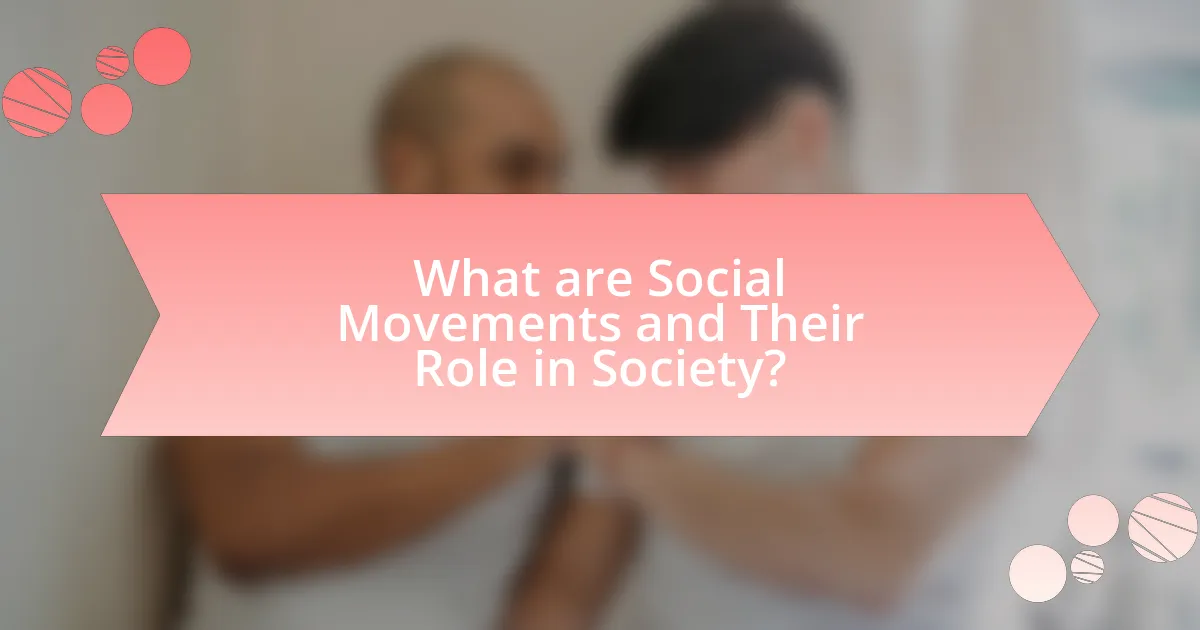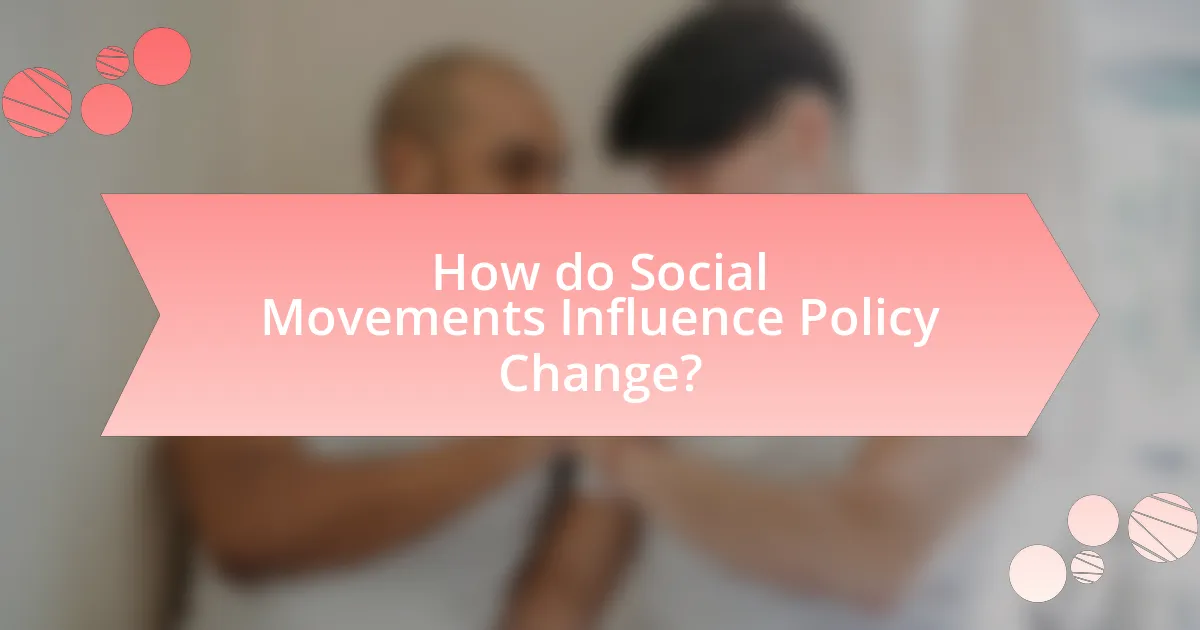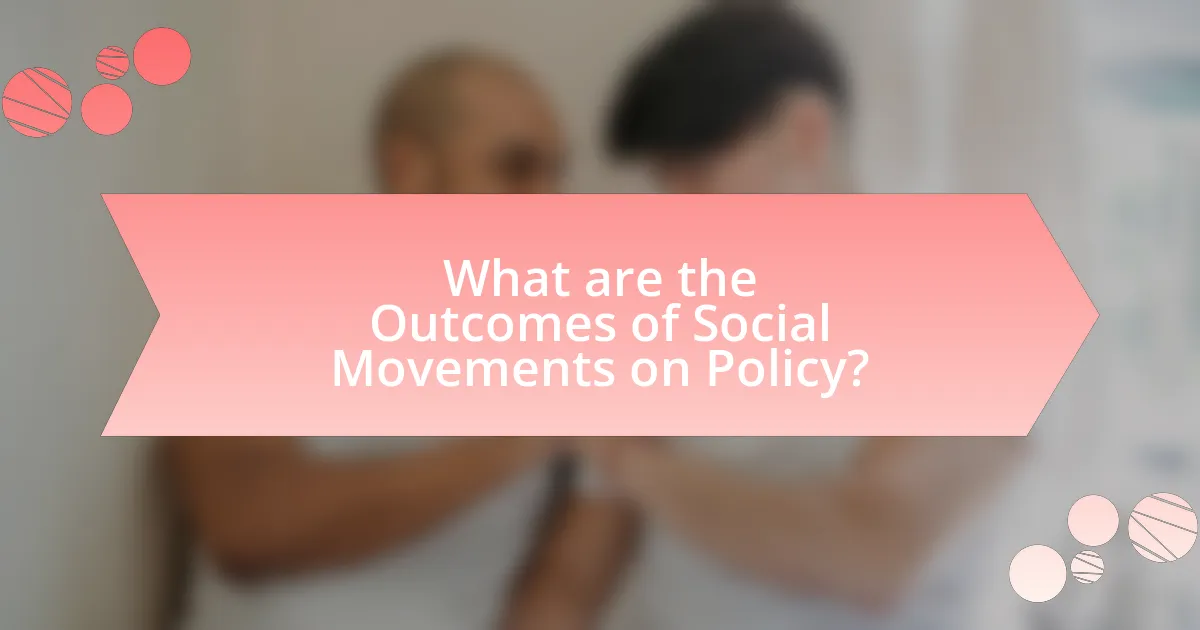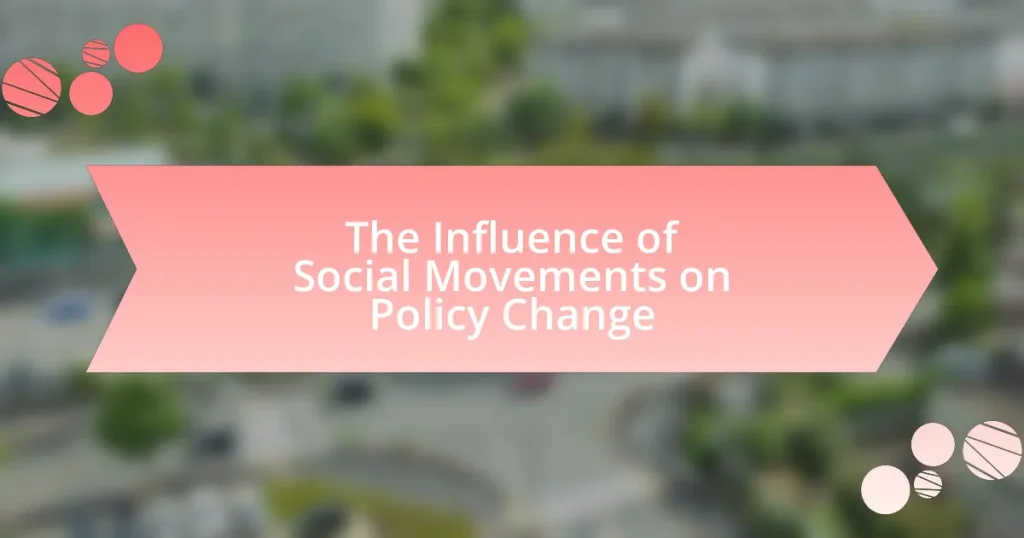Social movements are organized efforts by groups of people aimed at promoting or resisting social change, addressing issues such as civil rights, environmental protection, and economic inequality. They play a vital role in shaping public opinion and influencing policy decisions, as demonstrated by historical examples like the Civil Rights Movement, which led to significant legislative changes in the United States. The article explores how social movements emerge, develop, and gain public support, as well as the various types of movements and their mechanisms for affecting policy change. It also examines the challenges these movements face, the impact of counter-movements, and best practices for enhancing their effectiveness in advocating for policy reforms.

What are Social Movements and Their Role in Society?
Social movements are organized efforts by groups of people to promote or resist social change, often addressing issues such as civil rights, environmental protection, and economic inequality. They play a crucial role in society by raising awareness, mobilizing public opinion, and influencing policy decisions. For instance, the Civil Rights Movement in the United States led to significant legislative changes, including the Civil Rights Act of 1964, which outlawed discrimination based on race, color, religion, sex, or national origin. This demonstrates how social movements can effectively challenge existing norms and drive legislative reform, thereby shaping societal values and policies.
How do social movements emerge and develop?
Social movements emerge and develop through a combination of social, political, and economic factors that create a collective identity and mobilize individuals toward a common goal. Initially, grievances or injustices within a society, such as inequality or discrimination, spark awareness and concern among affected individuals. This awareness often leads to the formation of groups that articulate shared interests and objectives, fostering a sense of solidarity.
As these groups organize, they utilize various strategies, including protests, advocacy, and coalition-building, to gain visibility and support. Historical examples, such as the Civil Rights Movement in the United States, illustrate how grassroots activism can lead to significant policy changes, as seen with the Civil Rights Act of 1964. The development of social movements is also influenced by external factors, such as political opportunities, media coverage, and the responses of authorities, which can either facilitate or hinder their progress.
In summary, social movements emerge from collective grievances, develop through organization and mobilization, and are shaped by the broader socio-political context.
What factors contribute to the formation of social movements?
Social movements are formed due to a combination of factors including social grievances, collective identity, political opportunities, and mobilizing structures. Social grievances arise from perceived injustices or inequalities, prompting individuals to seek change. Collective identity fosters a sense of belonging among participants, which strengthens commitment to the movement. Political opportunities, such as favorable political climates or elite divisions, can facilitate mobilization. Mobilizing structures, including organizations and networks, provide the necessary resources and coordination for collective action. Historical examples, such as the Civil Rights Movement in the United States, illustrate how these factors interact to create powerful social movements that influence policy change.
How do social movements gain public support?
Social movements gain public support through effective communication, mobilization strategies, and the ability to resonate with the values and concerns of the broader population. By utilizing social media platforms, traditional media, and grassroots organizing, movements can amplify their messages and reach diverse audiences. For instance, the Civil Rights Movement in the United States effectively used television coverage to highlight injustices, which garnered national sympathy and support. Additionally, research indicates that movements that frame their issues in relatable terms, such as human rights or social justice, tend to attract more public backing, as seen in the global response to climate change activism led by figures like Greta Thunberg.
What types of social movements exist?
There are several types of social movements, including reform movements, revolutionary movements, resistance movements, and expressive movements. Reform movements aim to change specific policies or practices within existing systems, such as the civil rights movement in the United States, which sought to end racial segregation and discrimination. Revolutionary movements seek to completely overthrow existing political systems, exemplified by the Russian Revolution of 1917. Resistance movements focus on opposing specific policies or actions, such as environmental movements resisting deforestation. Expressive movements emphasize personal or cultural identity, like the rights movement, which promotes acceptance and equality. Each type of movement plays a distinct role in influencing policy change and societal norms.
What distinguishes reform movements from revolutionary movements?
Reform movements seek gradual change within existing political and social systems, while revolutionary movements aim for a complete overhaul of those systems. Reform movements, such as the civil rights movement in the United States, focus on specific issues like equality and justice, advocating for policy changes through established channels. In contrast, revolutionary movements, like the Russian Revolution of 1917, often involve mass mobilization and can lead to the establishment of entirely new political structures. The distinction lies in the approach and the extent of change sought; reform movements work within the system, whereas revolutionary movements reject the system entirely.
How do identity-based movements differ from issue-based movements?
Identity-based movements focus on the rights and recognition of specific social groups defined by characteristics such as race, gender, or sexual orientation, while issue-based movements concentrate on specific policy changes or social issues, such as environmental protection or healthcare reform. For example, the Civil Rights Movement aimed to secure equal rights for African Americans, emphasizing identity, whereas the environmental movement seeks to address climate change through policy advocacy. This distinction is evident in how identity-based movements often seek to reshape societal norms and values, whereas issue-based movements typically target legislative or regulatory changes.

How do Social Movements Influence Policy Change?
Social movements influence policy change by mobilizing public opinion, advocating for specific issues, and pressuring policymakers to enact reforms. For instance, the Civil Rights Movement in the United States led to significant legislative changes, including the Civil Rights Act of 1964 and the Voting Rights Act of 1965, by raising awareness about racial injustices and rallying widespread support. Research indicates that social movements can shift political agendas and create a sense of urgency around particular issues, compelling lawmakers to respond to constituents’ demands.
What mechanisms do social movements use to affect policy?
Social movements use various mechanisms to affect policy, including advocacy, mobilization, and coalition-building. Advocacy involves raising awareness and influencing public opinion through campaigns, protests, and media engagement, which can lead to increased pressure on policymakers. Mobilization refers to organizing individuals and communities to participate in collective actions, such as demonstrations or lobbying efforts, which can demonstrate public support for specific policy changes. Coalition-building involves forming alliances with other organizations and stakeholders to amplify their influence and resources, thereby enhancing their ability to impact policy decisions. Historical examples include the Civil Rights Movement, which utilized these mechanisms to achieve significant legislative changes like the Civil Rights Act of 1964.
How do protests and demonstrations lead to legislative changes?
Protests and demonstrations lead to legislative changes by mobilizing public opinion and pressuring lawmakers to address specific issues. When large groups of people gather to express their demands, they draw media attention, which amplifies their message and raises awareness among the general public. This heightened visibility can create a sense of urgency for legislators to act. For example, the Civil Rights Movement in the 1960s, characterized by protests and demonstrations, directly influenced the passage of the Civil Rights Act of 1964 and the Voting Rights Act of 1965. These legislative changes were a response to the widespread public outcry and demands for equality and justice, showcasing how sustained activism can result in concrete policy outcomes.
What role do advocacy and lobbying play in policy influence?
Advocacy and lobbying play a crucial role in influencing policy by directly engaging with decision-makers to promote specific interests or causes. Advocacy involves raising awareness and mobilizing public support around an issue, while lobbying focuses on direct interaction with legislators and government officials to persuade them to adopt particular policies. For instance, organizations like the American Civil Liberties Union (ACLU) utilize both strategies to influence legislation related to civil rights, demonstrating the effectiveness of coordinated efforts in shaping policy outcomes. Research indicates that lobbying expenditures significantly correlate with favorable legislative results, underscoring the impact of these activities on policy formation.
Why is public opinion important for social movements?
Public opinion is crucial for social movements because it shapes the legitimacy and support for their causes. When a movement aligns with the prevailing sentiments of the public, it can mobilize greater participation, attract media attention, and influence policymakers. For instance, the Civil Rights Movement in the United States gained momentum as public opinion shifted towards supporting racial equality, leading to significant legislative changes such as the Civil Rights Act of 1964. This demonstrates that favorable public opinion can enhance a movement’s effectiveness in achieving its goals and driving policy change.
How do social movements shape public discourse and awareness?
Social movements shape public discourse and awareness by mobilizing collective action and framing issues in ways that resonate with the public. These movements utilize various communication strategies, including social media campaigns and public demonstrations, to highlight social injustices and advocate for change. For instance, the Black Lives Matter movement has significantly influenced discussions around racial inequality and police reform, leading to increased public awareness and policy debates. Research indicates that social movements can alter public perceptions and priorities, as seen in the rise of environmental awareness driven by movements like Fridays for Future, which has prompted discussions on climate policy at national and international levels.
What strategies do movements use to sway public opinion?
Movements use various strategies to sway public opinion, including grassroots mobilization, media engagement, and framing issues effectively. Grassroots mobilization involves organizing community members to participate in demonstrations, rallies, and local events, which can create a visible presence and draw media attention. For example, the Civil Rights Movement utilized sit-ins and marches to highlight racial injustices, significantly influencing public perception and policy. Media engagement includes leveraging traditional and social media platforms to disseminate messages, share personal stories, and counter opposing narratives. The #MeToo movement effectively used social media to amplify voices of survivors, shifting societal attitudes towards sexual harassment. Additionally, framing issues in relatable terms helps movements connect with broader audiences; for instance, environmental movements often frame climate change as a public health issue, making it more accessible to the general public. These strategies collectively enhance a movement’s ability to shape public discourse and influence policy outcomes.

What are the Outcomes of Social Movements on Policy?
Social movements can lead to significant policy changes by raising awareness, influencing public opinion, and pressuring decision-makers. For instance, the Civil Rights Movement in the United States resulted in landmark legislation such as the Civil Rights Act of 1964 and the Voting Rights Act of 1965, which dismantled institutionalized racial segregation and ensured voting rights for African Americans. Additionally, the environmental movement has led to policies like the Clean Air Act and the establishment of the Environmental Protection Agency, demonstrating how organized advocacy can shape legislative agendas and regulatory frameworks. These outcomes illustrate the tangible impact social movements have on policy formulation and reform.
What successful examples illustrate the impact of social movements on policy?
Successful examples illustrating the impact of social movements on policy include the Civil Rights Movement in the United States, which led to the passage of the Civil Rights Act of 1964 and the Voting Rights Act of 1965. These legislative changes were a direct result of organized protests, advocacy, and public pressure from activists seeking to end racial segregation and discrimination. Another example is the rights movement, which significantly influenced the legalization of same-sex marriage in various countries, including the landmark Supreme Court decision in Obergefell v. Hodges in 2015, which legalized same-sex marriage nationwide in the U.S. These movements demonstrate how collective action can effectively shape and change public policy.
How did the Civil Rights Movement lead to significant legislative changes?
The Civil Rights Movement led to significant legislative changes by mobilizing public opinion and pressuring lawmakers to address racial discrimination. Key events, such as the 1963 March on Washington and the violent responses to peaceful protests, highlighted the urgent need for reform. This activism culminated in landmark legislation, including the Civil Rights Act of 1964, which prohibited discrimination based on race, color, religion, sex, or national origin, and the Voting Rights Act of 1965, which aimed to eliminate barriers to voting for African Americans. These laws were direct responses to the demands and activism of the Civil Rights Movement, demonstrating its profound impact on American policy.
What lessons can be learned from environmental movements in policy advocacy?
Environmental movements in policy advocacy demonstrate the importance of grassroots mobilization, strategic framing, and coalition-building. Grassroots mobilization engages communities and raises awareness, as seen in the success of the 1970 Earth Day, which mobilized 20 million Americans and led to significant environmental legislation. Strategic framing helps to communicate issues effectively, exemplified by the framing of climate change as a public health crisis, which has garnered broader support. Coalition-building among diverse stakeholders, such as NGOs, scientists, and affected communities, enhances credibility and influence, as evidenced by the collaboration in the Paris Agreement negotiations. These lessons highlight the effectiveness of inclusive, well-structured advocacy efforts in driving policy change.
What challenges do social movements face in achieving policy change?
Social movements face significant challenges in achieving policy change, primarily due to political resistance, fragmentation within the movement, and limited resources. Political resistance occurs when established power structures, such as government officials or corporate interests, actively oppose the demands of social movements, often leading to legislative gridlock or backlash. Fragmentation within the movement can weaken its effectiveness, as differing ideologies and goals may create divisions that hinder unified action. Limited resources, including funding and organizational capacity, restrict the ability of social movements to mobilize supporters, conduct advocacy campaigns, and sustain long-term efforts. For instance, the civil rights movement in the United States faced intense opposition from state authorities and systemic racism, which delayed significant policy changes despite widespread public support.
How do counter-movements affect the goals of social movements?
Counter-movements significantly impact the goals of social movements by opposing their objectives and often redirecting public discourse. For instance, when a social movement advocates for policy changes, a counter-movement may emerge to resist those changes, thereby creating a polarized environment that complicates the original movement’s goals. Historical examples include the civil rights movement, where counter-movements, such as segregationist groups, sought to maintain the status quo, ultimately delaying progress and forcing civil rights activists to adapt their strategies. This dynamic illustrates how counter-movements can not only challenge the legitimacy of social movements but also influence their tactics and messaging to regain public support.
What barriers exist in the political system that hinder policy change?
Barriers in the political system that hinder policy change include institutional inertia, partisan polarization, and lobbying by special interest groups. Institutional inertia refers to the resistance to change within established political structures, which can slow down or block new policies. Partisan polarization creates a divide between political parties, making it difficult to reach consensus on policy issues. Additionally, lobbying by special interest groups often prioritizes the interests of a few over the public good, further complicating the policy-making process. These factors collectively create a challenging environment for effective policy change.
What best practices can social movements adopt to enhance their impact on policy change?
Social movements can enhance their impact on policy change by employing strategic coalition-building, effective communication, and grassroots mobilization. Coalition-building allows diverse groups to unite around common goals, increasing their collective power and influence; for example, the Civil Rights Movement successfully partnered with various organizations to amplify its message and reach. Effective communication, including the use of social media, enables movements to disseminate information rapidly and engage a broader audience, as seen in the #MeToo movement, which utilized platforms to raise awareness and drive policy discussions. Grassroots mobilization empowers individuals to participate actively in advocacy efforts, exemplified by the climate strikes led by youth activists, which pressured policymakers to address climate change. These practices collectively strengthen the ability of social movements to effect meaningful policy change.
How can social movements effectively engage with policymakers?
Social movements can effectively engage with policymakers by utilizing strategic advocacy, coalition-building, and evidence-based lobbying. Strategic advocacy involves clearly articulating demands and aligning them with policymakers’ agendas, which increases the likelihood of gaining attention and support. Coalition-building enhances influence by uniting diverse groups to present a stronger, unified voice, as seen in the Civil Rights Movement, where various organizations collaborated to push for legislative change. Evidence-based lobbying, supported by research and data, provides policymakers with concrete information that underscores the importance of the proposed changes, exemplified by the successful advocacy for climate policy reforms backed by scientific studies.
What role does coalition-building play in strengthening movements?
Coalition-building plays a crucial role in strengthening movements by uniting diverse groups around common goals, thereby amplifying their collective voice and resources. This collaboration enhances the movements’ capacity to mobilize supporters, share knowledge, and increase visibility, which can lead to greater influence on policy change. For instance, the Civil Rights Movement in the United States effectively utilized coalition-building among various organizations, such as the NAACP and SCLC, to coordinate efforts and achieve significant legislative victories like the Civil Rights Act of 1964. This historical example illustrates how coalition-building not only consolidates power but also fosters strategic alliances that can drive systemic change.
